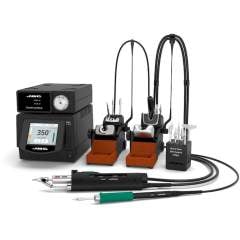JBC's Contribution to Advanced Soldering Applications
JBC's Contribution to Advanced Soldering Applications
Blog Article
JBC Soldering Solutions for Complex Electronics
Automation and activity control techniques are rewriting the principles of production, logistics, and also power management. Behind the curtain, groundbreaking products and powerful improvements are operating efficiency, sustainability, and productivity to remarkable new heights. What makes these options this kind of hot esd workplace topic, and why are they topping tendency provides in commercial circles?

Shaping the Future with Numbers and Styles
Nowadays, around 60 per cent of factories in advanced economies have applied some degree of computerized activity control. Contemporary receptors, electric pushes, and digital controllers now underpin sets from robotics to conveyor belts. In accordance with a 2023 report, the worldwide movement control market alone is expected to achieve $21 billion by 2027. That number presents a compounded annual growth charge (CAGR) of 6.5 percent, featuring so just how anxious industries are to adopt high-precision automation.
But it's not just traditional factories which can be benefitting. Circulation centers across North America and Europe are reimagining workflows through smart conveyor programs and autonomous vehicles. These improvements increase throughput by as much as 30 %, cut labor charges, and lower problem prices across fast-paced source chains.
Precision Matches Productivity
High-precision movement engineering has changed into a must-have in groups challenging reliability and reliability. Semiconductor production is an example, where linear activity courses and multi-axis controllers supply precision tested in microns. New surveys show that companies leveraging these options see problem prices decrease by as much as 40 percent, giving them a significant side in a fiercely aggressive field.
Renewable energy and e-mobility are seeing related revolutions. Breeze and solar installations significantly depend on real-time automation to enhance energy capture and streamline maintenance. This clever approach helps cut downtime, with one examine noting a 20 per cent lowering of maintenance fees at features that have followed automatic get a handle on systems.
The Intelligent Manufacturer Revolution
Automation is no longer just about reducing individual error. It's about producing wise factories, wherever all communicates seamlessly. Systems offering predictive analytics and IoT connectivity monitor equipment health and estimate preservation wants before breakdowns occur. Research shows that predictive maintenance may reduce unplanned downtime by as much as 50 per cent, translating into significant savings for place operators.
From automotive suppliers ramping up production rate to logistics firms seeking precise handling and power savings, the figures inform a powerful story about any of it accelerating sector. In the event that you monitor current developments or shape buying choices, understanding wherever the industry is headed is crucial.
What's Next for Automation and Action Control?

The focus on sustainability, data-driven production, and smarter supply restaurants will simply grow. Global demand for robotics and intelligent controllers continues to rise, particularly in areas where effectiveness and versatility mean survival. Industries investing in next-generation automation are setting themselves apart—with the numbers to show it.
For companies mapping out their next shift, automation and motion get a handle on are getting less of an option and more of a necessity. With returns assessed in larger output, decrease prices, and new abilities, the event for adoption has never been clearer.
Report this page